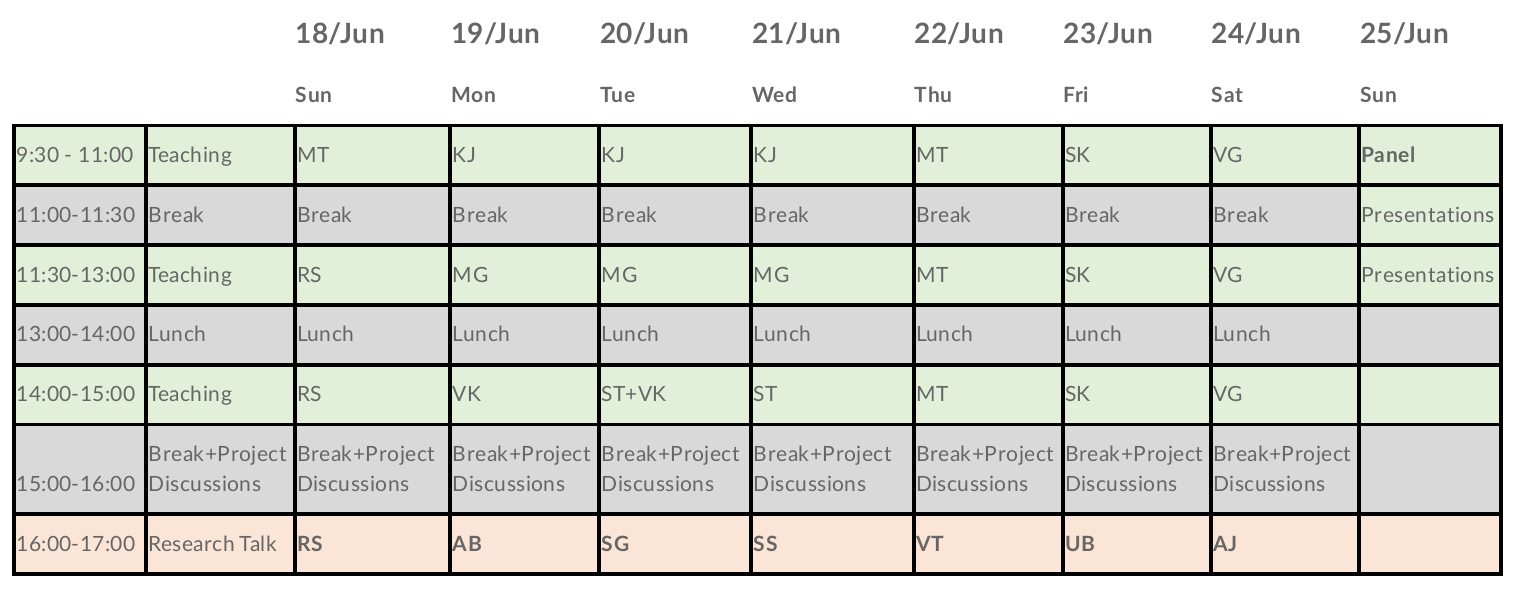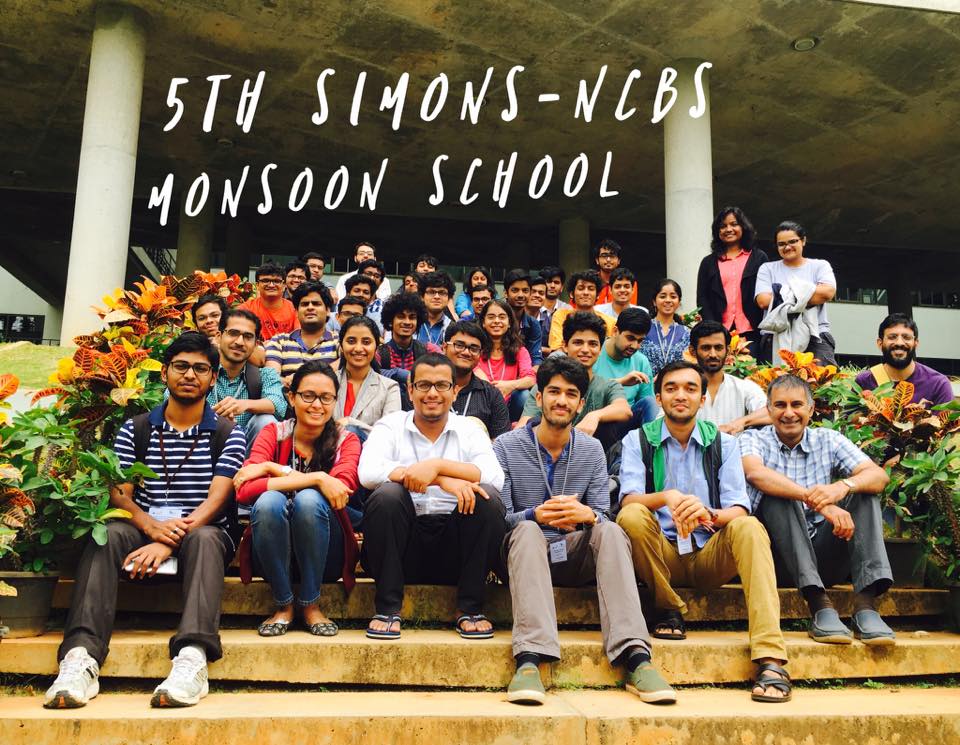Physics of Life 2017
Monsoon school on biology by Simons@NCBS
Frans Johansson, in his popular bestseller book The Medici Effect, makes an argument:
The intersection is the best place to innovate. These innovations change the world in leaps along new directions by opening up new fields, creating new information and allowing creators to become leaders. This intersection is the place where wildly different ideas from various areas bump into each other and build upon each other.
He goes on to illustrate, with examples and appealing case studies, how starting from artists and painters in the ancient city of Florence to the Charles Darwin and modern day scientists, by working at the intersection, have pushed the boundaries of knowledge and technology beyond comprehension. Such advances have revolutionized the way we live today by integrating into the deepest spheres of our lives.
But despite significant advances in recent decades, there are more questions to explore than ever before. We are witnessing a fundamental shift in the nature and method of the scientific discovery process from the past. Single disciplinary science is becoming rarer, and so is the era of monogamous collaboration. A lot of exciting stuff is coming from the people working on the interfaces and borrowing ideas from multiple disciplines. Thanks to the internet and digital revolution, highly collaborative and consortium like projects are becoming a norm and are being increasingly proposed and carried out.
In such a rapidly transforming world of science, it would be naive to imagine a world of biology without the use of advances in physics, chemistry, mathematics and engineering. That is where a program like the Physics of Life comes into the picture.
Physics of Life
Physics of Life is an annual monsoon school organized by Simons Centre for Study of Living Machines at National Centre for Biological Sciences (NCBS), Bangalore. NCBS is a research institute, a unit of Tata Institute of Fundamental Research (TIFR), specializing in biological research. It is worth mentioning that TIFR and its centres are one of the top contributors to total research output from India. Van Noorden, R. (2015, May 13). India by the numbers. Nature. Springer Nature. https://doi.org/10.1038/521142a
The school consists of a seven-day program involving didactic lectures, research talks, laboratory visits, interactive sessions, and a final project component. Aimed principally at science undergraduates across all disciplines, the school seeks to expose students to an interdisciplinary approach towards doing science, and motivate them to seek problems at the interface of biology and other sciences.

The program featured pedagogic lectures with researchers from NCBS, ICTS, IIT Bombay, IMSc, JNCASR, and IISc delivered to a class of 37 students. Mukund Thattai kick-started the school with a preview of numbers in biology and building the motivation of problem-solving using reasoned estimates and scientific methodology. Rahul Siddhartan from IMSc talked about modeling biological sequences with a brief review of Bayesian probability, Markov models, and alignment algorithms.
Teachings
From Monday to Wednesday, Kavita Jain from JNCASR talked about the modern synthesis of evolution and how it has evolved from Darwin’s original ideas from The Origin of Species. With a discussion on important evolutionary processes, she delved into ideas of population genetics using simple models (Hardy-Weinberg equilibrium, Wright-Fisher process for example) to understand the role of genetic drift, mutation, selection and stochasticity in a population.
Manoj Gopalkrishnan from IIT Bombay talked about implications of life and what does it mean to be living, from a biological and physical point of view. He then build upon those ideas to draw a parallel between thermodynamics of a cell and information theory, discussing the design and limitations of Maxwell’s demon and Szilard’s engine; and finally building towards The Szilard-Landauer Correspondence. Gopalkrishnan Manoj (2013, Nov 15). The Hot Bit I: The Szilard-Landauer Correspondence. arXiv:1311.3533v2
Vijay Krishnamurthy from ICTS studies physical biology and soft-condensed matter physics, and he built upon the same ideas. Posing questions like What states of matter are biological systems in and how are they constituted? He provided a conceptual background of Brownian motion and how a study of dynamics from the related principles (Reaction-diffusion system, for example) could give rise to complex emergent phenomenon such as Turing patterns formation—an interesting study of which is the digit patterning in a mouse. Coming from a biological background, I was highly impressed by Vijay’s lecture and the way he told his story.
On Thursday, Mukund Thattai got back to his ideas from the first day and posed a question on the precision of life. Specifically, how precise is life and how is his precision generated? For demonstration, he discussed the famous paper by Berg and Purcell (1977). However, in his approach, he relied very little on the directly borrowing ideas from the article and instead discussed the assumptions and approach from the ground up. In fact, he went as far as to derive and explain the calculation of sample mean and variance. In his last lecture, he discussed his paper on stochastic/noisy expression of single gene and modeled its dynamics. Ozbudak, E. M., Thattai, M., Kurtser, I., Grossman, A. D., & van Oudenaarden, A. (2002, April 22). Regulation of noise in the expression of a single gene. Nature Genetics. Springer Nature. https://doi.org/10.1038/ng869
On Friday, Sandeep Krishna from NCBS held an interactive session in which we had to borrow ideas from biological systems and develop them into a playable game. A few exciting games from the session are now posted on the Simons Games blog.
On the final day before the presentation, Vishu Guttal from IISc focused on broader ecological aspects of evolution discussing how organisms interact with each other in a community and ways to understand their behavior theoretically and empirically. A famous example of predator-prey dynamics was also discussed.
Finally, on the last day we had a career counseling session where we discussed exciting aspects of continuing in science and what does it mean to do research as a PhD student and a PI. The take home lesson was that a PhD is not supposed to be a world changing exercise or an attempt at becoming the best in the world (what most students suggested). Rather, it is more of an independent exercise and a critical milestone towards gaining exposure to the field of research: a form of apprenticeship but with more independence and a demand of novelty and rigor. Following this session, different groups presented what they have been working on during the school.

Overall, the school provided a must-needed brush up after months of hiatus due to summer vacations. Discussions with professors and how they are doing science raised some interesting questions that I have been thinking about. I am hoping to share some of it shortly. However, I also feel that the lecture-style theme of the school along with the depth to which the contents were covered are more suitable for junior students, preferably those in their sophomore or junior years. Lastly, the school provided an excellent opportunity to meet new friends and learn from their interest and enthusiasm.